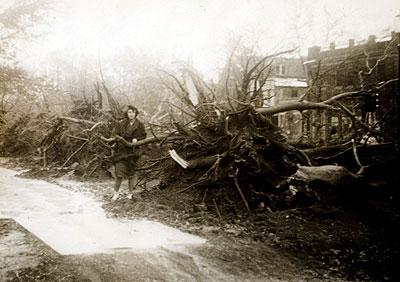Lessons From the 1938 Disaster

As of Friday morning, the National Hurricane Center had revised its prediction of Hurricane Irene's path, placing it directly over Long Island Sunday. This course is strikingly similar to that said to have been taken by the 1938 Hurricane, which killed an estimated 600 people.
That earlier storm that arrived without warning on Sept. 21, 1938, was considerable stronger than Irene is predicted to be. However, the damage from the 1938 storm may give an indication of the kinds of effects that will begin to be seen on Long Island Sunday.
Unlike today, in 1938 there were very few methods to predict a storm's path or intensity. On the two days before that storm, the Weather Bureau had only two reports from ships at sea on which to base its forecast. Though that hurricane has been said to have moved with an unheard-of 60 miles-per-hour forward speed, the paucity of actual scientific observations has lead some experts on the 1938 Hurricane to conclude that its movement may have been in fact somewhat less rapid.
Slideshow: Images from after the 1938 Hurricane
In any event, what is known is that the 1938 Hurricane slammed ashore on Long Island at about 4 p.m., with its eye centered about Patchogue. This trajectory placed the strongest winds on eastern Long Island, eastern Connecticut, and the Rhode Island shore.
In the Northern Hemisphere, hurricane winds blow counter-clockwise. Because of this, a storm centered at mid–island will probably most powerfully effect the area to the east of the eye. Its winds will come first from the east and northeast, but as it moves inland, they will shift and blow from the northwest.
The circling pattern of wind combined with a surge of high water can lead to flooding in surprising places. In 1938, as the wind began to shift to the northwest, Fort Pond Bay rushed into the Montauk fishing village, wiping out many of the lightly built houses and destroying dozens of boats. Residents sought shelter on high ground at the Montauk Manor.
The East Hampton Star reported this in its issue of Sept. 22, 1938: "The 100-mile-an-hour hurricane which lashed the Atlantic seaboard from Cape Hatteras through New England, struck eastern Long Island with full force on September 21, taking a heavy toll of lives and causing damage far into the millions.
"From Westhampton to Montauk Point the lashing fury ripped and tore at everything in its path, inflicting heavy damage upon substantial dune estates and reducing beach cabanas and frame buildings to kindlingwood."
Because, unlike today, there was no warning of the impending storm, the human toll of the 1938 Hurricane was fearsome.
Six men aboard the menhaden steamer Ocean View out of Promised Land died when it foundered off the Connecticut shore.
Twenty-nine people in Westhampton Beach were reported drowned as the surge rose over the dunes and swept away nearly all of the houses there.
Train and mail service was interrupted for two weeks due to washouts on the Long Island Rail Road tracks. Swathes of Napeague and what is now Beach Hampton disappeared under the surge waters.
On Main Street in East Hampton Village, alone, from Woods Lane to the Hook Mill, 164 large trees -- many of the town's emblematic elms -- came down.
Across New England and Long Island, 1,754 people were injured, and more than 93,000 households suffered reportable losses, according to insurers; 7,000 vacation houses and "cottages" were destroyed, as were 2,000 permanent, year-round houses. Flooding ravaged inland New England for days.
Precautions are being taken today that were impossible in those days. And while it remains to be seen just how similar or dissimilar Irene will be to its wrathful predecessor, authorities are advising residents and visitors to err on the side of caution and prepare for the worst. The Long Island Rail Road has canceled eastbound trains; highway departments on the East End are preparing tree-removal equipment, and citizens are being warned to put aside thoughts of wave-watching and keep away from beaches and other low-lying areas for the duration.
